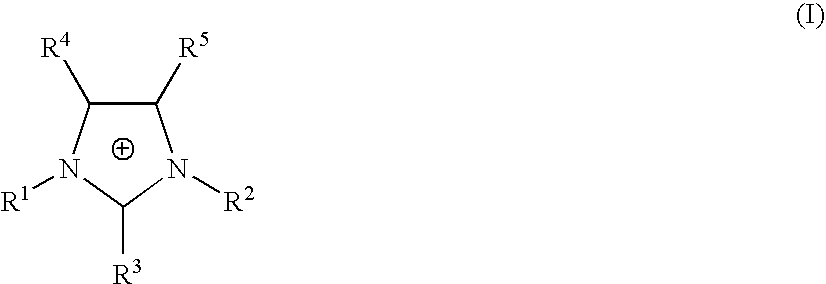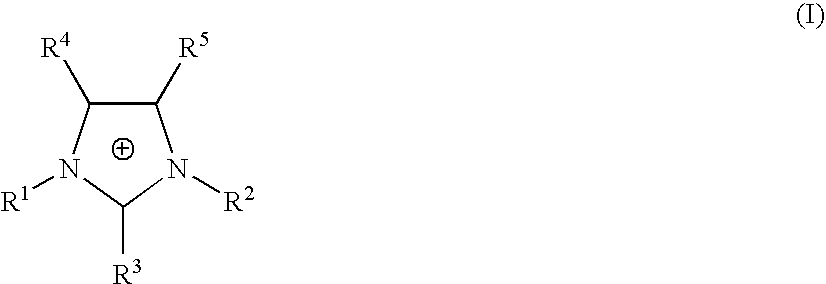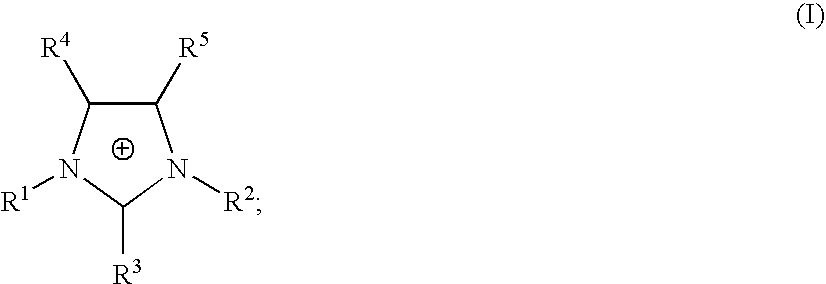Composition containing lonic liquid clay stabilizers and/or shale inhibitors and method of using the same
a technology of lonic liquid clay and stabilizer, which is applied in the direction of fluid removal, chemistry apparatus and processes, and well accessories, etc. it can solve the problems of reducing the flow rate and stability of the surrounding formation, shale and/or other earth formation materials are often problematic, and the influx of shale into the drilling fluid is often problematic, so as to reduce the influx of permeability, inhibit the disintegration and/or prevent the swelling
- Summary
- Abstract
- Description
- Claims
- Application Information
AI Technical Summary
Benefits of technology
Problems solved by technology
Method used
Image
Examples
examples
[0035]In the Examples, the following materials were used:
[0036]1-ethyl-3-methylimidazolium chloride (“IC 1”), an ionic liquid;
[0037]methyl-tri-n-butylammonium methylsulfate (“IC 2”), an ionic liquid;
[0038]tris (2-hydroxyethyl-methyl-ammonium methyl sulfate) (“IC 3”), an ionic liquid;
[0039]CLAY MASTER 5C, a cationic clay stabilizer, a product of BJ Services Company; and
[0040]CLAY TREAT-3C, a clay stabilizer substitute for potassium chloride, a product of BJ Services Company.
examples 1-13
[0041]The effectiveness of ionic liquids on clay stabilization was evaluated in a sand / clay mixture by measuring the amount of aqueous clay slurry released as a filtrate. Approximately 250 ml of base fluid was placed into a Waring blender. About 30 grams of a sand / clay mixture (24.9 grams of silica flour and 5.1 grams of bentonite clay) was then added to the blender and the admixture mixed for 5 minutes at high speed. The slurry was then placed into a 500 ml glass beaker and allowed to hydrate for 25 minutes. After 15 minutes, the slurry was remixed with a glass stirring rod and a 1 ml sample was used in a filtration time test using a Capillary Suction Time (CST) instrument. The CST data was recorded in seconds and repeated to obtain consistent readings.
[0042]The beaker contents were then transferred to a Fann filter press while stirring the slurry to avoid any phase separation. The Fann filter press was comprised of a metal cylinder having a bottom aperture covered with a wire mesh...
examples 14-28
[0045]The procedure of Examples 1-13 was repeated except that, prior to the addition of the sand / clay mixture, an ionic liquid additive was added to the base fluid. The resulting admixture was then mixed for about 2 minutes. The clay / sand mixture was then added. The results are set forth in Table II:
TABLE IICSTEx.Additives / mls of fluid / minutesTimeNo.Base FluidConcentration013510(sec.)142% KCl in DI2 gpt IC312122***25.8water232 cc @ 136 seconds152% KCl in DI4 gpt IC310144***20.8water232 cc @ 100 seconds16DI Water + 2 gpt2 gpt IC3672144210*32.8Clay Treat-3C227 cc of fluid @ 340 seconds17DI Water + 2 gpt4 gpt IC3590172**30.1Clay Treat-3C230 cc of fluid @ 272 seconds182% KCl in DI1 gpt (75% by vol.6125***20.0waterIC1 in DI water)245 cc at 122 seconds192% KCl in DI2 gpt (75% by vol.6140***17.5waterIC1 in DI water)225 cc at 104 seconds20DI Water + 2 gpt1 gpt (75% by vol.274136184*39.8Clay Treat-3CIC1 in DI water)200 cc at 331 seconds21DI Water + 2 gpt2 gpt (75% by vol.588174**26.0Clay Tre...
PUM
| Property | Measurement | Unit |
|---|---|---|
| composition | aaaaa | aaaaa |
| swelling | aaaaa | aaaaa |
| volume | aaaaa | aaaaa |
Abstract
Description
Claims
Application Information
 Login to View More
Login to View More - R&D
- Intellectual Property
- Life Sciences
- Materials
- Tech Scout
- Unparalleled Data Quality
- Higher Quality Content
- 60% Fewer Hallucinations
Browse by: Latest US Patents, China's latest patents, Technical Efficacy Thesaurus, Application Domain, Technology Topic, Popular Technical Reports.
© 2025 PatSnap. All rights reserved.Legal|Privacy policy|Modern Slavery Act Transparency Statement|Sitemap|About US| Contact US: help@patsnap.com



